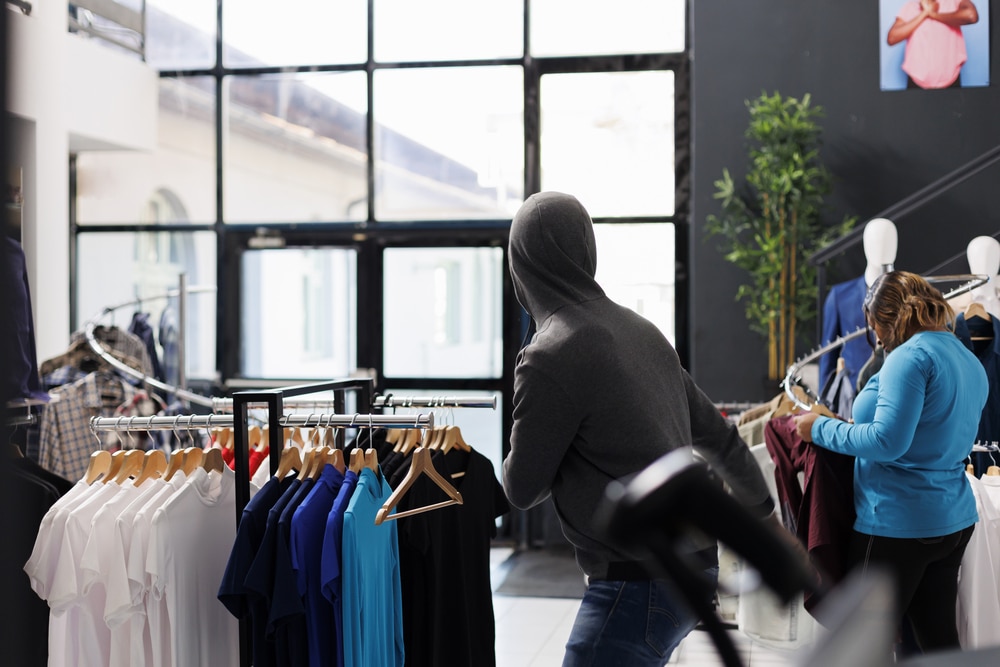Article At A Glance
- Strategies such as surveillance systems, visible security personnel, anti-theft devices, and store layouts can help prevent shoplifting.
- Employee theft is also a major concern, with preventive strategies like employee training and background checks being crucial.
- Cybersecurity threats are increasing in the retail industry, highlighting the importance of secure payment systems, network security, and data encryption.
Running a retail store comes with its share of challenges, and security is one of the most important. Retail businesses face various security risks, from theft to cybersecurity threats, that can impact their operations and bottom line. Understanding these risks and how to prevent them can make all the difference in protecting your store, employees, and customers. This blog will explore five common security risks in retail stores and how to prevent them.
How to Prevent Shoplifting in Retail Stores
Risk:
Shoplifting is a primary concern for retailers. It leads to inventory loss, financial damage, and increased operational costs. Criminals often use sophisticated tactics to steal, making it harder for store employees to detect. In addition to direct theft, shoplifting also drives up the cost of insurance and security.
Prevention:
Preventing shoplifting starts with creating a secure environment that discourages thieves from targeting your store. Here are some strategies to reduce shoplifting:
- Surveillance Systems: Install high-quality security cameras throughout your store, especially in areas where theft is most likely. Use advanced systems with features like motion detection and remote monitoring to ensure you can detect suspicious behavior in real-time.
- Visible Security Personnel: Retail security guards are a powerful deterrent against theft. Having visible personnel on the floor can make thieves think twice before acting. Their presence helps prevent theft and creates a safer environment for employees and customers.
- Anti-theft Devices: Place anti-theft tags and alarms on high-value items and ensure they are always activated. If stolen, these devices can trigger an alarm, allowing staff to take immediate action.
- Store Layout and Design: Organize your store layout to minimize blind spots and ensure employees can easily see all areas. Keep high-risk items, such as electronics or jewelry, near the front of the store or under lock and key.
Strategies to Reduce Employee Theft in Retail
Risk:
Employee theft is another major issue in retail environments. Employees may steal items or misuse store resources, causing significant financial losses. This type of theft is particularly challenging to detect because the perpetrators have inside knowledge of the store’s operations and security systems.
Prevention:
Implementing preventative strategies that foster accountability and discourage dishonest behavior helps protect your business from employee theft.
- Employee Training and Awareness: Train your staff on the importance of security and make them aware of company policies regarding theft. Ensure they understand the consequences of theft and the importance of reporting suspicious behavior.
- Employee Vetting: Conduct thorough background checks during hiring to screen for any previous criminal activity. Hiring trustworthy employees reduces the risk of internal theft.
- Clear Policies and Audits: Create clear, written policies regarding inventory handling, cash management, and store procedures. Regularly audit inventory and review sales transactions to identify any discrepancies.
- Use of Technology: Implement systems that track employee actions, such as POS systems and access controls to sensitive areas. This way, you can easily monitor employee activities and ensure everything is on board.
Safeguarding Against Cybersecurity Threats in Retail
Risk:
In today’s digital age, retail stores are increasingly becoming targets for cybersecurity threats. These threats range from data breaches to hacking attempts and ransomware attacks. A customer data or financial information breach can damage your reputation and lead to legal consequences.
Prevention:
Implementing robust cybersecurity measures is essential to safeguard your retail business against these types of threats:
- Secure Payment Systems: To protect customer financial data, use secure payment systems with encryption. Ensure that your point-of-sale (POS) terminals are regularly updated and equipped with the latest security features.
- Employee Cybersecurity Training: Train your employees on the importance of cybersecurity, including best practices like using strong passwords and avoiding phishing scams.
- Network Security: Invest in firewalls, antivirus software, and intrusion detection systems to monitor your network and prevent unauthorized access. Regularly update your security software and patches to protect against new threats.
- Data Encryption: Encrypt sensitive customer and business data in transit and at rest. This ensures that even if hackers can access your data, they won’t be able to read or use it.
Protecting Your Store from Burglary and Break-ins
Risk:
Burglary and break-ins are serious risks for retail businesses, particularly during non-operating hours. Criminals may target your store for valuable items or cash, resulting in significant property damage and financial losses.
Prevention:
To protect your store from burglaries and break-ins, you need to invest in both physical and technological security measures:
- Alarm Systems: Install an effective alarm system that includes motion detectors, door/window sensors, and glass-break detectors. Ensure your system is linked to a 24/7 monitoring service for rapid response in case of a break-in.
- Reinforced Entry Points: Reinforce entry points such as doors and windows with high-quality locks, deadbolts, and security bars. Consider installing security film on windows to prevent them from shattering easily.
- Lighting and Visibility: Keep the exterior of your store well-lit in the evening. Criminals who feel exposed are less likely to attempt a break-in. Use motion-sensor lights around your store’s perimeter to deter unwanted visitors.
- Security Cameras: Surveillance cameras are crucial for deterring burglars and providing evidence in case of a break-in. Ensure cameras are positioned to monitor entrances, exits, and vulnerable areas.
Detecting and Preventing Fraudulent Transactions in Retail
Risk:
Fraudulent transactions are an increasing issue for retailers, with criminals using stolen credit card information or fake IDs to make purchases. These fraudulent activities can lead to significant financial losses and damage to your store’s reputation.
Prevention:
To prevent fraudulent transactions, you need to implement strong procedures and systems:
- Transaction Verification: Use point-of-sale systems that include fraud detection tools, such as real-time credit card verification and checks for suspicious activity.
- Employee Training: Ensure employees are trained to recognize signs of fraudulent transactions, including unusual payment methods or suspicious customer behavior.
- ID Checks: For high-value transactions or purchases made with a credit card, train employees to check customer IDs and compare them with the payment method.
- Secure Payment Processing: To ensure the security of customer payments, work with payment processors that offer advanced fraud prevention tools, such as tokenization and multi-factor authentication.
Additional Read: 5 Retail Store Security Tips: Optimizing Safety and Minimizing Loss
Secure Your Store with Stark Security’s Custom Solutions!
The retail industry faces various security risks, but with the proper precautions, these risks can be effectively managed and minimized. Implementing robust physical security measures, investing in cybersecurity defenses, and training employees to recognize and prevent theft and fraud can help protect your store, employees, and customers.
At Stark Security, we specialize in providing tailored security solutions that address the unique challenges of retail businesses. Contact us today at 773-455-1220 to learn how our retail security services can safeguard your business and provide peace of mind.















